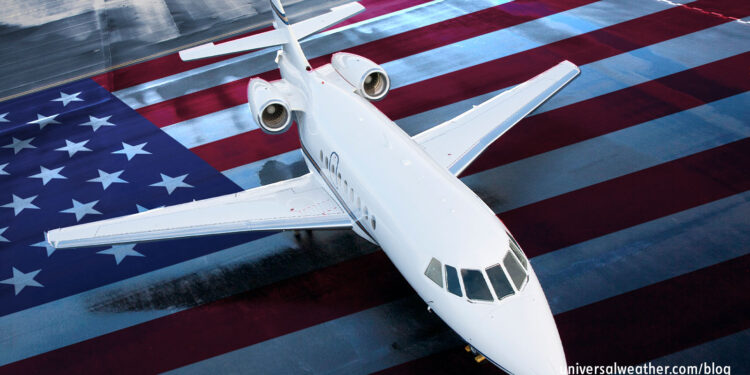Private Jet Ops to the U.S.: Part 2 – Procedural Considerations

This business aviation blog post continues from our article last week, entitled “Private Jet Ops to the U.S.: Part 1 – Documentation Requirements.”
When conducting operations to the U.S. in a non-U.S.-registered business aircraft, it’s always important to consider any local restrictions and/or operating procedures that may impact your flight. Be aware that charter (non-scheduled commercial) operators face additional procedural requirements.
The following is an overview of what you need to know:
1. Check for TFRs
A Temporary Flight Restriction (TFR) is a geographically limited, short-term airspace restriction that temporarily shuts down access to particular airports and/or surrounding areas. TFRs may be issued when a major event – such as the Super Bowl – is in progress or for VIP movements to certain airports. Once a TFR is issued, no unauthorized operators may move within the designated airspace, and this is non-negotiable. TFR restrictions are published by notice to airmen (NOTAM) and usually issued within 24-72 hours of a closure.
2. Special-route clearance may be required
Aircraft registered in “special-interest countries” – China, Cuba, Iran, North Korea, Sudan, Russia, and Syria – must obtain special-route clearance prior to operating within U.S. airspace or airspace of U.S. territories. This route clearance is issued by the Federal Aviation Administration (FAA). It’s important to note that aircraft registered in Hong Kong, Macau, and Taiwan are not currently subject to these requirements. For operators who require this clearance, five business days’ advance notification is necessary. Short-notice requests may be possible at the discretion of the Transportation Security Administration (TSA) and the FAA. Special-route clearance is valid for a period of between 24 and 72 hours. Revisions are needed for any requested change of route or change of schedule outside the validity period. Once the FAA approves a route, the operator may request a routing modification, but it’s at FAA’s discretion to approve/disapprove the request. If an operator that requires a special-route clearance travels within U.S. airspace without appropriate permission, or deviates from an approved routing, he or she may be liable to fines or being banned from U.S. airspace. For more information on this type of clearance, please see our article entitled “What You Need to Know about FAA Special-Route Clearances.”
3. Additional requirements
For travel to the U.S., a customs decal is needed, and once obtained it’s valid for the calendar year. For example if you obtain the customs decal in March, it will expire on December 31 of that year. Customs decals show that you’ve paid customs fees, and decals are needed for both private non-revenue and charter (non-scheduled commercial) operations. If you’re bringing guns onboard, be sure to notify customs in advance and ensure that any required paperwork is completed. For operators bringing animals into the U.S., all vaccinations need to be up to date, a health declaration needs to be completed, and customs must be notified in advance.
4. Plan on sufficient lead time for international arrivals
Depending on required documentation, lead times will vary when you plan operations to the U.S. For example if you need to obtain a TSA waiver, five business days’ lead time is needed. Keep in mind that you will require full customs clearance with supporting documentation, even for international tech stops within the U.S.
5. Confirm customs operating hours and any clearance limitations in advance
It’s important to check customs operating hours, and any overtime policies, prior to flying to any U.S. airport. If customs arrangements have been made, and a delay is anticipated, be sure to notify the local customs office. If a delay puts your arrival outside of normal customs operating hours, you may have to change your destination or delay your trip. Note that there are Airports of Entry (AOEs) that cannot process certain non-U.S. nationals or Electronic System for Travel Authorization (ESTA) participants due to lack of equipment. In such cases another AOE may need to be considered. For this reason it’s always important to advise your 3rd-party provider or local customs port of the nationality of all crew members/passengers onboard.
Conclusion
Know what documentation and permits are required prior to travel to the U.S. Allow plenty of lead time to arrange certain approvals – such as customs bonds and arrangements – and always have a contingency plan ready in case you’re unable to travel to your intended destination.
Questions?
If you have any questions about this article or would like more information on non-U.S.-registered aircraft traveling to the U.S., contact me at greglinton@univ-wea.com.



